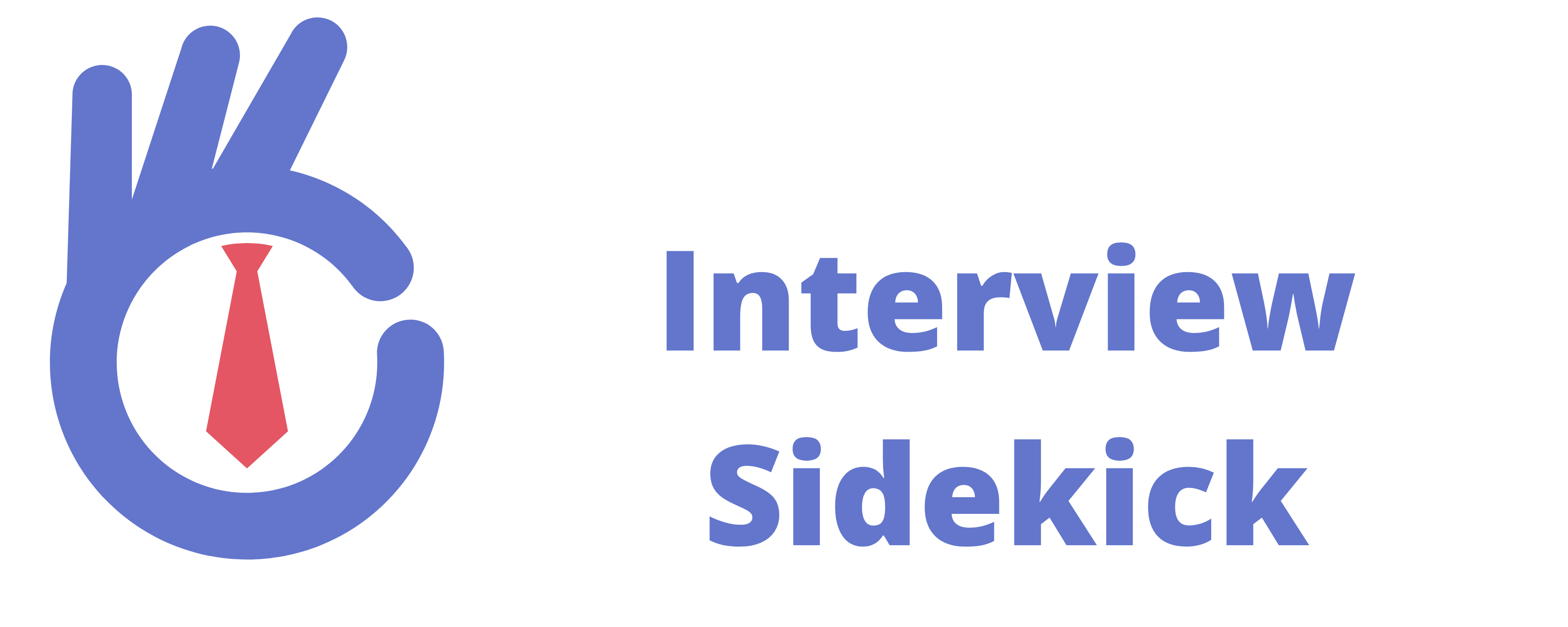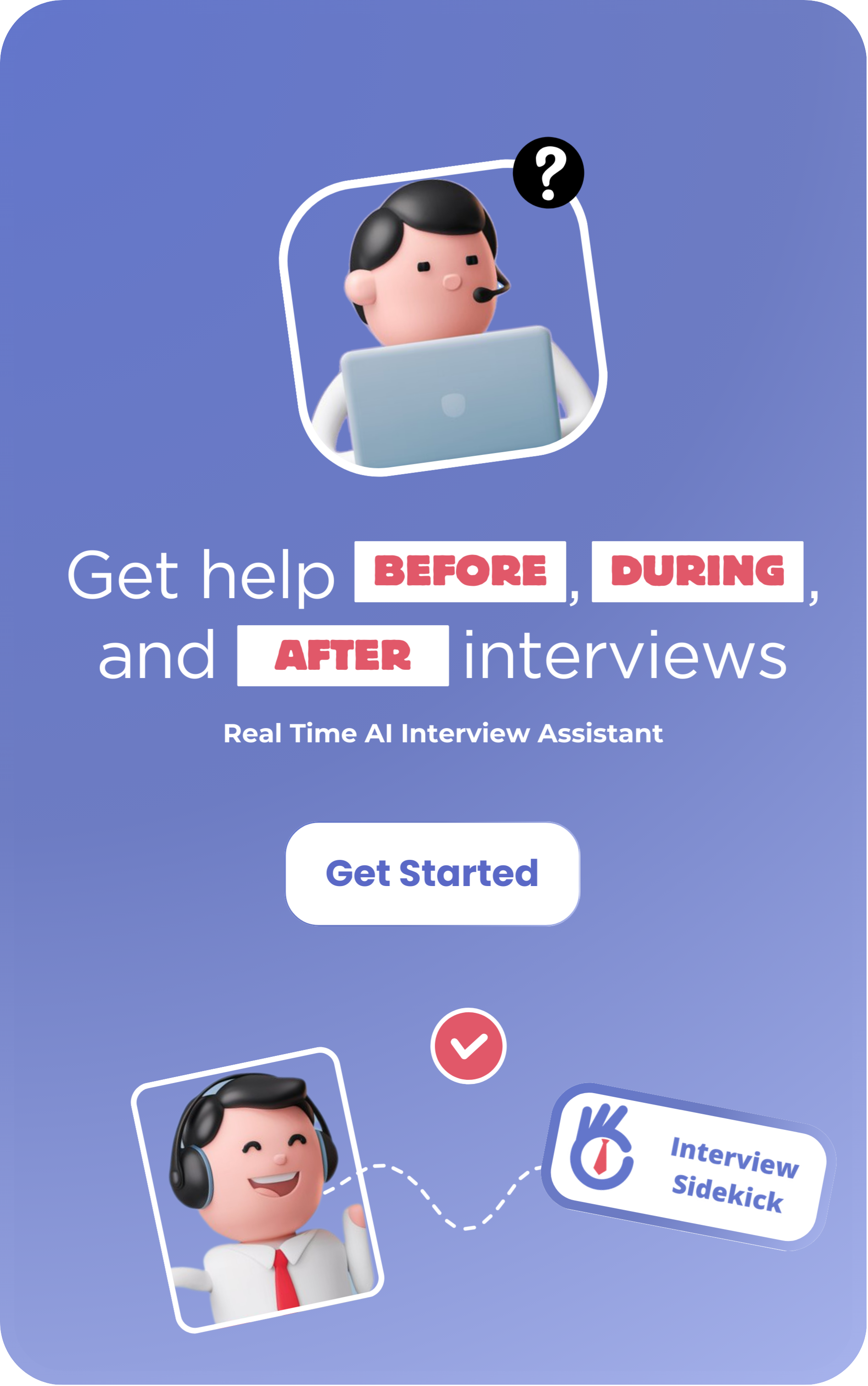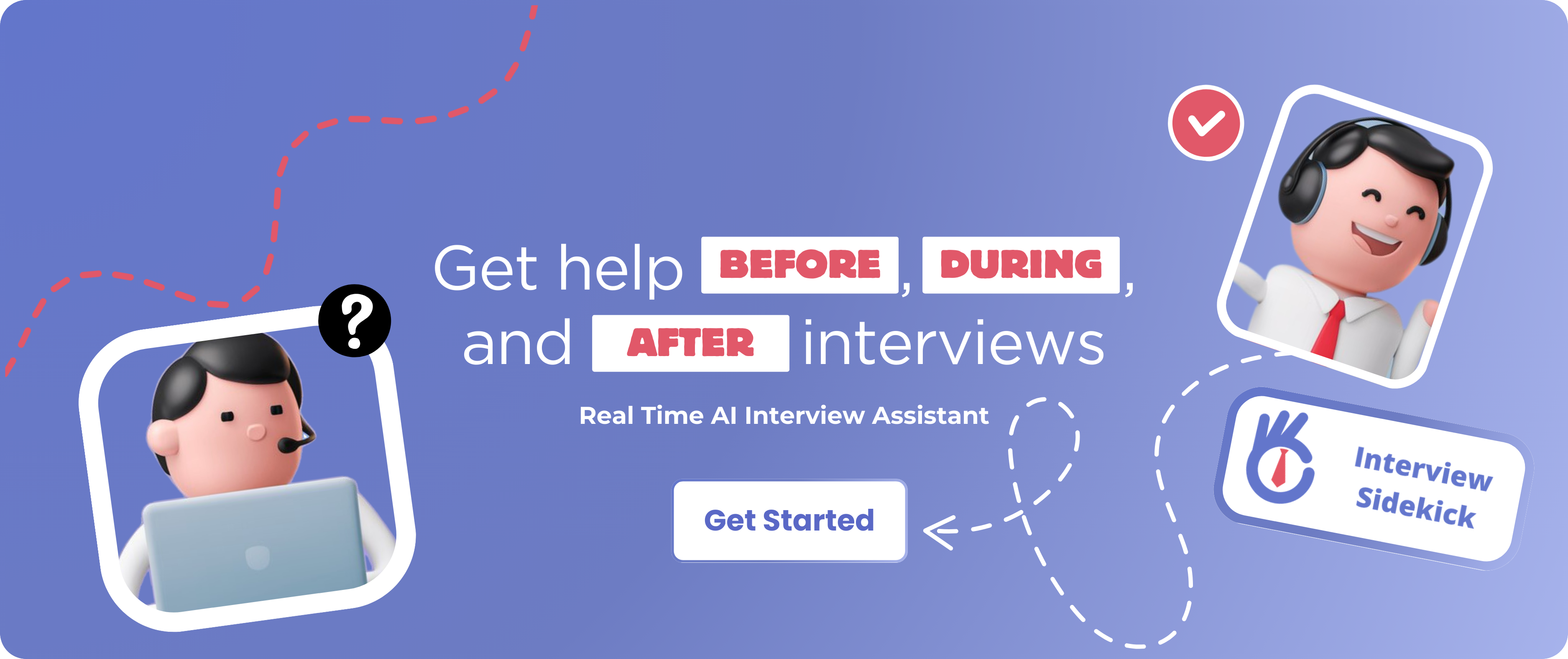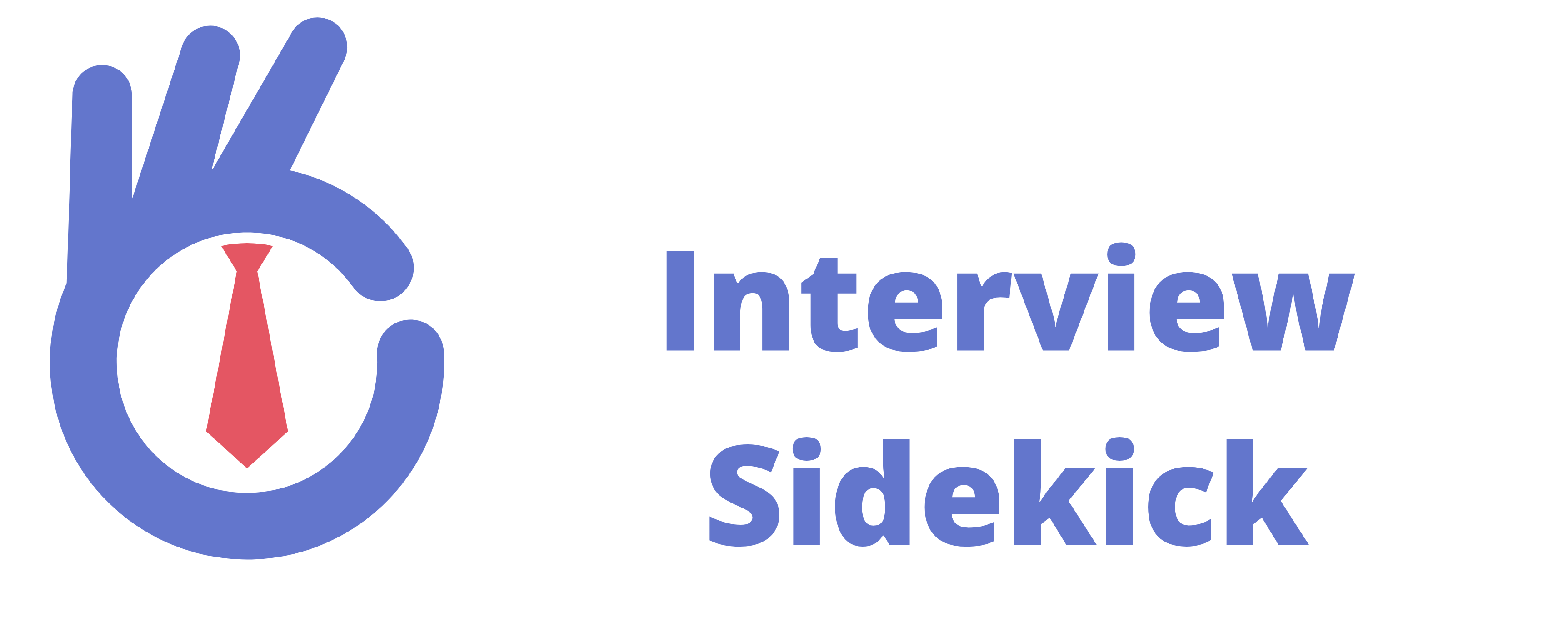Preparing for Amazon most asked software questions requires more than technical expertise. Clear communication, strategic thinking, and also being aligned with Amazon’s Leadership Principles are a must.
You must be very strategic from mastering data structures and algorithms to designing scalable systems and sharing impactful stories. Remember, success lies only through continuous practice.
And in this article, we will guide you through how to answer Amazon’s most-asked software questions. We will provide you with actionable strategies to help you stand out among other contestants.
Not only that, we will also introduce you to Interview Sidekick an AI Interview assistant that helps provide realistic mock scenarios, expert feedback, and tailored tips to nail that interview!
Let’s get you ready to get that job!
Key Areas of Focus in Amazon Interviews
1. Data Structures
The ability to implement scalable data structures and clearly articulate the thought process and approach of that implementation can be the key difference between a good and an exceptional software engineer.
Common Scenarios:
- Explaining how to find duplicates in an array
- Describing approach behind implementing a queue or stack
- Walking through how to design a hash map from scratch
How Interview Sidekick Helps
Step 1: Go to Interview Prep
Once you arrive at this landing page you will be given two options. Select the option that resonates with how you want to practice your interview.
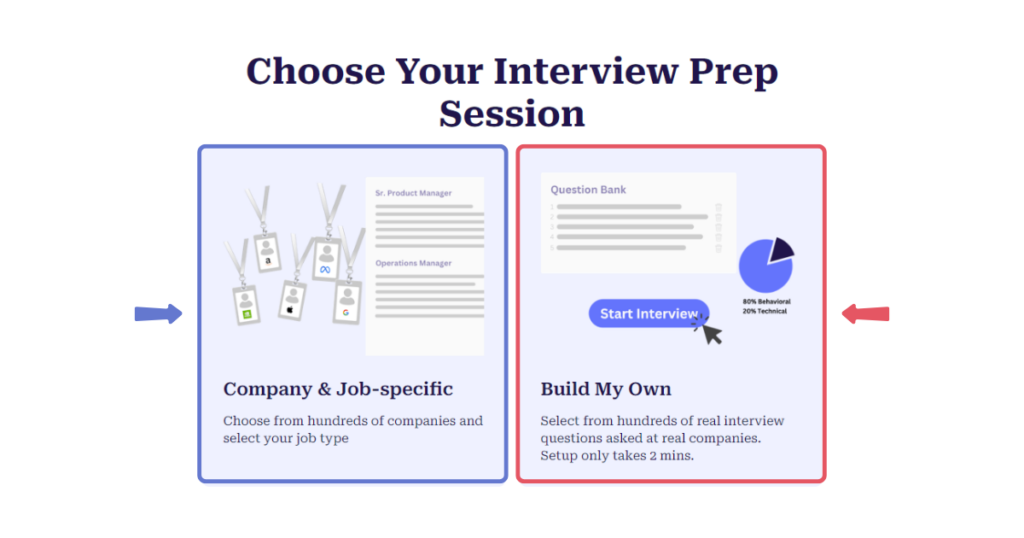
If you want to build your own interview questions and practice with Interviewsidekick, you can click on the right-hand option, Build My Own.
It will take you to build the questions and you can answer the questions and get feedback on clarity and grammar score. It will also tell you how to improve your answers.
If you want the questions that are constantly updated in our database, select the left option; Company and Job Specific. This feature contains all the interview questions that we have acquired from immense research and data, that are used in real company interviews.
Step 02: Company and Job-Specific Option
You will be provided with a list of companies to suit various types of interviews. However, for this interview guide, we will be targeting Amazon. Because this company is what you are aiming to get hired. So please go ahead and select Amazon.

Step 03: Select the Type of Job You Want to Practice for
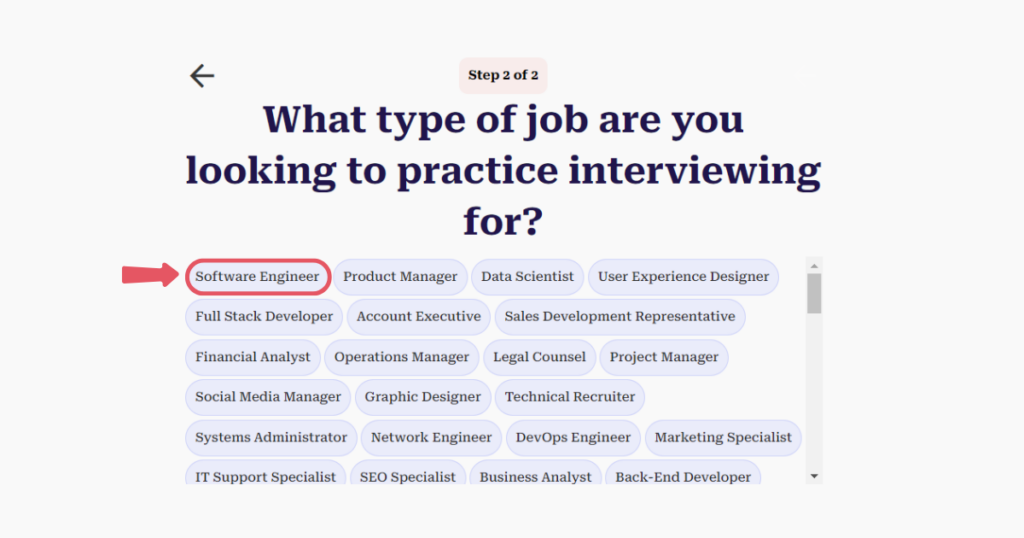
Next, select your desired role, that you want to get hired for. In this case scenario, we will choose ‘Software Engineer’.
Step 04: You Made It! Now It’s Time to Practice!
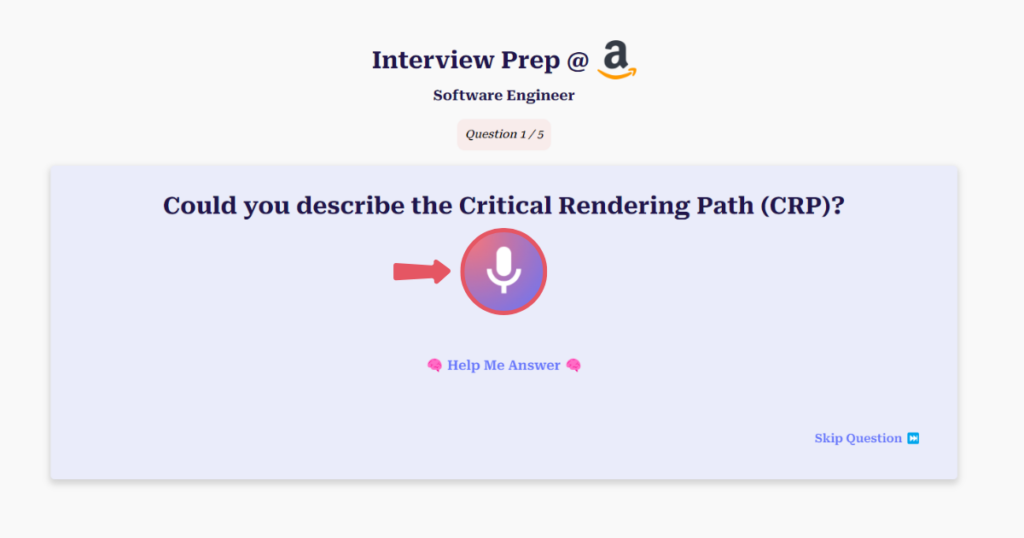
Click on the mic button to answer our researched and up-to-date interview questions tailored for Amazon Software Development Engineers. We will provide you with thorough feedback after your responses.
Step 05: Time To Improve

After you’ve completed your interview rounds, you will be given an online assessment with accurate feedback on how you answered the interview questions. This is super helpful to all aspiring software development engineers who want to acquire a seat at the tech giant that is Amazon.
2. Algorithms
With the rise of AI, tech companies, including Amazon, focus primarily on a candidate’s proficiency with algorithms. However, the ability to talk through your choices—from simple sorting algorithms to complex machine learning networks—is just as important as solving the problem itself.
What to Expect:
- Sorting Algorithms: QuickSort, MergeSort, etc
- Searching Algorithms: Binary Search for optimized lookups
- Dynamic Programming: Breaking down technical challenges into subproblems for efficiency
Key Skills:
- Identifying whether the problem requires searching, sorting, or dynamic programming
- Explain why you’re choosing a specific algorithm for time and space efficiency.
3. System Design
For senior technical roles, you will be asked high-level design questions to evaluate your approach to designing scalable systems and identifying areas for improvement in existing infrastructure. This provides insight into your ability to articulate a high-level approach to complex systems. The difficulty of these design questions can range from designing a simple chat application to a highly complex backend infrastructure.
Common Topics of Discussion:
- Load Balancing for distributed systems
- Caching Mechanisms to Optimize Performance
- Database Sharding to handle large-scale data
Sample Problems
- “How would you design a scalable URL shortener?”
- “What’s your thought process behind designing an online chat application?”
4. Behavioral Assessments
Apart from testing your technical skills, Amazon’s behavioral interview tests you as a person to see if you fit in a leadership role. Built around its Leadership Principles, such as Ownership, Customer Obsession, and Bias for Action, you will be asked behavioral questions. Success in these depends on your ability to share clear, compelling stories that align with their principles.
Common Questions Include:
- “Tell me about a time you disagreed with a decision but committed to it.”
- “Describe a situation where you demonstrated ownership to solve a problem”
Key Strategy: Use the STAR Method (Situation, Task, Action, Result) to structure concise, results-focused answers.
Commonly Asked Questions
We suggest that you first try to come up with efficient solutions written in maintainable code for the following questions before looking at our optimal solution. This will help boost your problem-solving skills. We will be using the popular Python programming language for our solutions.
1. Two Sum
- Topics covered: Array, Hashmap
Given an array of integers and a target sum, return indices of the two numbers such that they add up to the target. You may assume that each input would have exactly one solution, and you may not use the same element twice.
Solution (Python):
def twoSum(nums, target):
num_hash = {}
for i, num in enumerate(nums):
# Calculate complement
complement = target - num
if complement in num_hash:
# Return the indices of the two numbers
return [num_hash[complement], i]
num_hash[num] = i
# If no solution is found
return []
result = twoSum([2, 7, 11, 15], 9)
print(result) # [0, 1]
This solution has:
- Time Complexity: O(n)
- Space Complexity: O(n)
Key Points:
- Uses a hashmap to achieve linear time complexity
- Checks for the complement of each number
- Returns the indices of the two numbers that sum to the target
- Handles the requirement of using each element only once
2. Longest Palindromic Substring
- Topics covered: Two Pointers, String
Given a string s, return the longest palindromic substring in s. A palindrome is a string that reads the same backward as forward.
Solution (Python):
def longestPalindrome(s):
if not s:
return ""
# Expand around center
def expand_around_center(left, right):
while left >= 0 and right < len(s) and s[left] == s[right]:
left -= 1
right += 1
return s[left + 1:right]
longest = ""
# Check palindrome for each possible center
for i in range(len(s)):
# Odd length palindromes
odd = expand_around_center(i, i)
# Even length palindromes
even = expand_around_center(i, i + 1)
# Update longest substring
if len(odd) > len(longest):
longest = odd
if len(even) > len(longest):
longest = even
return longest
result = longestPalindrome("pippiipp")
print(result) # "ppiipp"
This solution has:
- Time Complexity: O(n²)
- Space Complexity: O(1)
Key Points:
- Uses expand around center technique
- Checks for both odd and even length palindromes
- Handles different palindrome scenarios
- Efficiently finds the longest palindromic substring
3. Valid Parentheses
- Topics covered: Hashmap, String, Stack
Given a string containing just the characters ‘(‘, ‘)’, ‘{‘, ‘}’, ‘[‘ and ‘]’, determine if the input string is valid. An input string is valid if:
- Open brackets must be closed by the same type of brackets
- Open brackets must be closed in the correct order
- Every close bracket has a corresponding open bracket of the same type
Solution (Python):
def isValid(s):
bracket_map = {")": "(", "}": "{", "]": "["}
stack = []
# Iterate through each character in the string
for char in s:
# If it's a closing bracket
if char in bracket_map:
# Check if stack is empty or top doesn't match corresponding opening bracket
if not stack or stack[-1] != bracket_map[char]:
return False
# Remove the matching opening bracket from the stack
stack.pop()
else:
# If it's an opening bracket, push to stack
stack.append(char)
# Stack should be empty for all brackets to be valid
return len(stack) == 0
s1 = "()[]{}"
s2 = "([)]"
print(isValid("()[]{}")) # true
print(isValid("([)]")) # false
This solution has:
- Time Complexity: O(n)
- Space Complexity: O(n)
Key Points:
- Uses a stack to track opening brackets
- Employs a dictionary for efficient bracket matching
- Handles different types of brackets
- Checks for both matching and order of brackets
4. Integer to Roman
- Topics covered: Hashmap, String
Convert an integer to a Roman numeral. Roman numerals are represented by seven different symbols: I (1), V (5), X (10), L (50), C (100), D (500), and M (1000). Special rules apply for subtractive notation, where certain smaller values before larger values indicate subtraction.
Example:
- Input: num = 1994
- Output: “MCMXCIV”
- Explanation: M = 1000, CM = 900, XC = 90, IV = 4
Solution (Python):
def intToRoman(num):
values = [
(1000, "M"),
(900, "CM"),
(500, "D"),
(400, "CD"),
(100, "C"),
(90, "XC"),
(50, "L"),
(40, "XL"),
(10, "X"),
(9, "IX"),
(5, "V"),
(4, "IV"),
(1, "I")
]
roman = ""
# Iterate through value-symbol pairs
for value, symbol in values:
# While the number is greater than or equal to current value
while num >= value:
# Add corresponding symbol to result
roman += symbol
# Subtract the value from number
num -= value
return roman
print(intToRoman(1994)) # MCMXCIV
print(intToRoman(58)) # LVIII
This solution has:
- Time Complexity: O(1)
- Space Complexity: O(1)
Key Points:
- Uses a greedy approach with predefined value-symbol mappings
- Handles subtractive notation (like CM for 900)
- Efficiently converts integers to Roman numerals
- Works for standard Roman numeral range (1 to 3999)
Strategies for Responding to Questions
Let’s say you were given a question that you most certainly know the answer to. Guess what? Most technical assessments do not care about the final answer but focus more on how you approach, communicate, and optimize your solutions. Here are some must-dos to follow when facing any interview questions:
1. Ask Clarifying Questions
When trying to solve your technical interview questions, don’t just jump in, ensure you fully understand the problem. Ask types of questions that will help you find edge cases or obscurities.
- Sidekick’s Tip: Practice structuring these clarifying questions in mock sessions to avoid appearing hesitant.
2. Break Down Problems and Plan Solutions
Throughout the interview process, if you are stuck on any interview question,
Learn to:
- Break the problem into smaller parts.
- Walk interviewers through your plan before implementing anything.
This will shine a light on your technical skills and, more importantly, your problem-solving skills, even if you come up with a naive solution.
3. Verbalize Your Thought Process
Provide a clear reasoning for the decisions you make. If your explanation is too long, it will prolong other segments of the interview process. If it’s too short, it will hurt your chances in the coming interview rounds.
- How Sidekick Helps: Practice talking through solutions out loud, ensuring you articulate each decision with confidence.
4. Optimize and Test Your Solution
In the same way you guide a question to its most efficient solution with your coding skills, verbally walk through your process efficiently. Show that you’ve considered time complexity, space trade-offs, and potential improvements.
- How Sidekick Helps: Real-time feedback highlights areas where you can better discuss optimizations and edge cases.
Preparation Methods
1. Practicing Mock Interviews
Simulating Amazon interviews under realistic conditions helps you build confidence and improve your ability to think on your feet.
- Sidekick Advantage: Receive real-time, personalized feedback on every mock session.
2. Leveraging Coding Platforms (e.g., CodeSignal)
Practicing technical questions from platforms like LeetCode, HackerRank, and CodeSignal, combined with Interview Sidekick’s curated question sets, can help you excel in all aspects of a technical interview.
3. Reviewing Past Interview Experiences
The best way to gauge your interview skills is by reviewing past interviews or other real interviews. If your interviewer allows it, try recording the session from beginning to end. Afterward, go over the recording several times to identify areas where you performed better or worse. Were the challenges related to behavioral interview questions or coding interview questions? This is the best way to understand how strong your communication skills really are.
The Role of Amazon’s Leadership Principles
“Learn and Be Curious” is one of Amazon’s Leadership Principles, emphasizing that leaders should continuously seek knowledge to foster productive excitement not only for themselves but also for their peers. Amazon has 16 Leadership Principles that they expect candidates to understand and demonstrate during both online and onsite interviews.
Interview Sidekick provides practice questions specifically aligned with Amazon’s principles, such as:
- “Describe a time you took ownership of a challenging task.”
- “Tell me about a time you earned the trust of a team.”
Conclusion: Why Interview Sidekick is Your Amazon Prep Solution
To succeed in Amazon’s interview process, it’s not enough to write great code—you need to communicate effectively, articulate system designs, and demonstrate strong alignment with Amazon’s Leadership Principles.
How Interview Sidekick Helps:
- Realistic Mock Interviews: Simulate Amazon interviews for technical, system design, and behavioral questions.
- Expert Feedback: Receive actionable advice to improve clarity, structure, and confidence.
- Tailored Preparation: Practice the skills that matter most—verbal articulation, problem breakdown, and cultural alignment.
Final Tip: Use Interview Sidekick to refine your approach, gain confidence, and showcase your best self. With focused practice and personalized feedback, you’ll be ready to tackle every challenge Amazon throws your way.
Good luck—you’ve got this!
